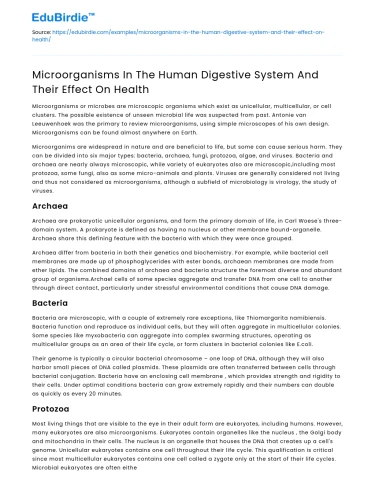Introduction
The human digestive system is a complex ecosystem, home to trillions of microorganisms collectively known as the gut microbiota. This diverse community includes bacteria, viruses, fungi, and protozoa, each playing a pivotal role in maintaining human health. Recent research highlights the profound impact of these microorganisms on various physiological functions, including digestion, immune modulation, and even mental health. The symbiotic relationship between humans and their gut microbiota illustrates the intricate balance necessary for homeostasis. Disruptions to this balance, often termed dysbiosis, have been linked to a host of disorders such as obesity, inflammatory bowel disease (IBD), and metabolic syndrome. This essay explores the essential functions of gut microorganisms, their influence on health, and the implications of microbial dysbiosis.
The Role of Gut Microorganisms in Digestion
Microorganisms in the gut are integral to the digestion and absorption of nutrients. They perform functions that the human body alone cannot achieve, such as breaking down complex carbohydrates, synthesizing vitamins, and fermenting non-digestible fibers. For instance, Bacteroides and Firmicutes, two dominant bacterial phyla in the gut, are adept at breaking down polysaccharides into short-chain fatty acids (SCFAs). According to a study by Flint et al. (2012), SCFAs, particularly butyrate, provide an energy source for colonocytes and play a role in regulating gut motility and inflammation. This fermentation process not only aids in nutrient absorption but also in maintaining gut health.
Save your time!
We can take care of your essay
- Proper editing and formatting
- Free revision, title page, and bibliography
- Flexible prices and money-back guarantee
Furthermore, gut microorganisms synthesize essential vitamins such as vitamin K and some B vitamins, contributing significantly to the host's nutritional status. The significance of these microbial activities is underscored by the fact that germ-free mice, which lack gut microbiota, exhibit deficiencies in these vitamins and show impaired digestion and immune function (Smith & Topping, 2013). Thus, the symbiotic relationship between humans and their gut microbiota is essential for efficient digestion and nutrient assimilation.
However, the complexity of these interactions also means that imbalances can lead to adverse effects. For instance, an overgrowth of certain bacteria can result in excessive gas production and symptoms of bloating and discomfort associated with conditions like small intestinal bacterial overgrowth (SIBO). This exemplifies the need for a balanced microbial community to maintain digestive health.
Gut Microbiota and Immune System Modulation
The gut microbiota plays a crucial role in the development and function of the host's immune system. It acts as a physical barrier against pathogenic microbes and influences the maturation of immune cells. Microbial metabolites like SCFAs have been shown to modulate immune responses by affecting the production of cytokines and the differentiation of regulatory T cells (Rooks & Garrett, 2016). Such interactions highlight the pivotal role of gut microorganisms in maintaining immune homeostasis and protecting against infections.
Moreover, the gut microbiota influences the systemic immune response, highlighting its role in conditions beyond the gut. For example, a study by Round and Mazmanian (2009) demonstrated that certain gut bacteria can induce the production of anti-inflammatory cytokines, reducing the risk of autoimmune diseases such as multiple sclerosis. This suggests that a healthy gut microbiota is not only essential for local immune function but also for systemic immune regulation.
Counterarguments suggest that not all interactions between the gut microbiota and the immune system are beneficial. Dysbiosis can lead to aberrant immune responses, contributing to inflammatory diseases. For instance, studies have linked an imbalanced gut microbiota to increased susceptibility to IBD and allergies (Shreiner et al., 2008). These findings underscore the delicate balance required for beneficial host-microbiota interactions and the potential consequences of microbial imbalance.
Influence of Gut Microbiota on Mental Health
Emerging research suggests a bidirectional communication pathway between the gut microbiota and the brain, often referred to as the gut-brain axis. This interaction indicates that gut microorganisms can influence mental health and behavior. For instance, studies have shown that alterations in the gut microbiota composition can affect stress responses, anxiety, and depression (Cryan & Dinan, 2012). The production of neurotransmitters and modulation of neural pathways by microbial metabolites are proposed mechanisms underlying this influence.
Real-life cases highlight the gut-brain connection's significance in mental health. For example, patients with irritable bowel syndrome (IBS), a condition often associated with dysbiosis, frequently report comorbid psychological disorders such as anxiety and depression (Kennedy et al., 2012). Treatment strategies targeting the gut microbiota, such as probiotics and dietary interventions, have shown promise in alleviating these symptoms, further supporting the microbiota's role in mental health.
Nevertheless, the complexity of the gut-brain axis implies that more research is needed to fully understand these interactions. Critics argue that while associations between gut microbiota and mental health are evident, causality remains to be firmly established. Consequently, ongoing research seeks to unravel the precise mechanisms and therapeutic potential of modulating the gut microbiota for mental health benefits.
Conclusion
The microorganisms inhabiting the human digestive system are indispensable allies in maintaining health and well-being. They contribute to efficient digestion, modulate immune responses, and influence mental health through the gut-brain axis. However, the delicate balance of this microbial ecosystem is crucial, as imbalances can lead to various health disorders. While substantial progress has been made in understanding the role of gut microbiota, further research is essential to elucidate the mechanisms behind their influence on health and to develop effective therapeutic interventions. As our knowledge of this complex ecosystem expands, the potential for novel treatments targeting the gut microbiota holds promise for enhancing human health and preventing disease.






 Stuck on your essay?
Stuck on your essay?

